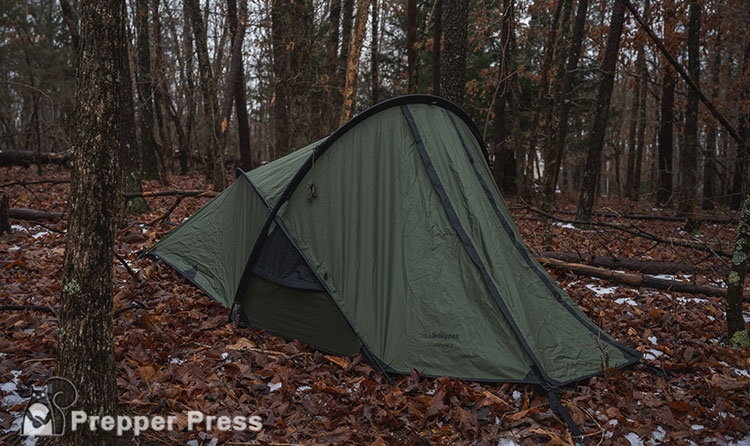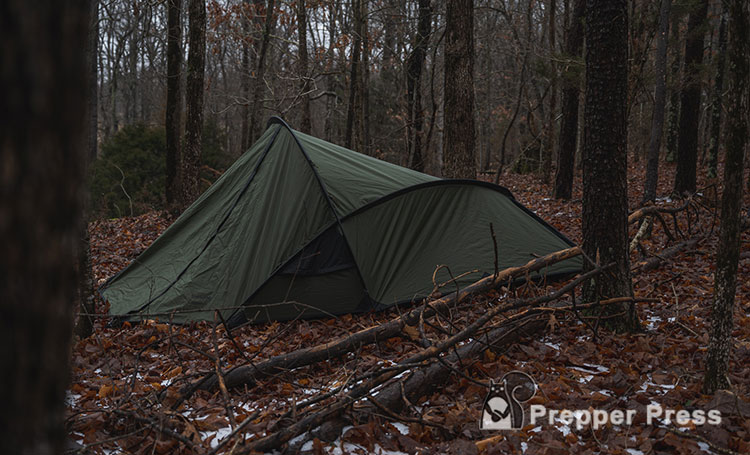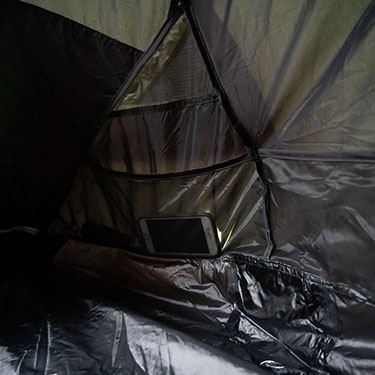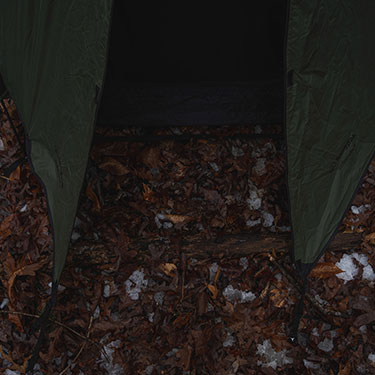
Looking for a new bug out bag tent? I finally acquired a new one, the Snugpack Scorpion 2. The name may not be familiar with many, and that’s what I’m writing this review, because I was pleasantly surprised by the cost-to-quality ratio.
If this tent proves to be something that fits your situation, you can find it available at both Amazon and Optics Planet (follow the links). Prices can vary depending on sales and availability, so check each one before buying.
I’ve done a lot of backpacking. Back in college it was one of the chief ways that I would spend my summer months. A summer without a trip felt somewhat as if it was missing something. It was this enjoyment that led to my section hiking a sizable portion of the Appalachian Trail. I say all this to say that I’ve a bit of experience under my belt when it comes to carrying everything I need on my back to live and sleep out in the woods.
If you’re going to pack a bug out bag and you have a family that you have to consider, then you are going to need a tent. The tent versus tarp debate is a fine one to have when you’re on your own, but that’s a completely different ballgame from when you have a spouse and children. Shoot, it’s even a different ballgame from when it’s severe weather outside.
You can only stay well-hidden in a stealth hammock, but it will only keep you so warm in the dead of winter. When you add wind and precipitation, you need something a bit sturdier. Let’s take a look at why I think the Scorpion 2 is the tent that I think you need to add to your bug-out bag.
Tent Weight
The first thing that surprised me with the Scorpion 2 was its weight. I’ve found through personal experience, that my limit for a backpack is 35 pounds if I’m going on a multi-day hike. Anything more than that just makes the trip a chore. Ideally, I like to get as close to 30 pounds as possible. That extra five pounds really makes a difference when you’re 20 miles in. I’m not quite into ultralight backpacking range, but the closer I can get the better.
The one thing that I always try to carry as much of as I can when I’m out on the trail is food. You can easily burn 4000+ calories a day from backpacking, and you’ll be miserable if you’re not replacing those calories. As such, I do everything I can to save weight. I eliminate any excess packaging to products, use lightweight cookware, and have a relatively light sleeping bag.
Any backpacker knows that the tent can be a main source of weight. The Scorpion 2 comes in at all of 5.84 pounds. For a tent – and a two-man tent – that’s really light. It means you can pack more food, leading to either a A) longer stay out in the woods, or B) a more enjoyable shorter stay. Either way is a win.
A lighter pack also means that you can move faster. Most of us create and carry our bug out bag (BOB) around because we understand that there may be a time where we need to get the heck out of dodge, and fast. Mobility is one of the key things to keep in mind while preparing our BOB. Too heavy of a pack, and you’re not going to be able to put as much distance between you and any threats. If you picture attempting to escape the middle of a post-EMP city with 35 pounds on your back versus 28, I think you’ll see what I mean.
Packability
Aside from weight, it’s been the lack of space within a backpack that always comes back to bite me. I always end up with every pocket on my bag just about bursting from the seams. If you’re taking a bag out in the woods to help keep you alive – and maybe even to relocate – you need to have as much of what you need as possible. Disasters don’t really give you a heads up when it comes to their timeline. You don’t know how long they’re going to last, and really, you don’t know how long it’s going to take you to get to your retreat. It’s better to have as much of the essentials with you as possible.
I found the Scorpion 2 to help with that as well. My hiking backpack completely swallowed the thing. My BOB – which is significantly smaller – nestled it incredibly well too, and with plenty of space to spare (read our guide on selecting the best bug out backpack).
Set Up and Tear Down Time
In a survival situation, the quicker that you can put up and tear down your tent the safer you will be. Let’s say that it’s pouring rain outside and it’s cold. Incredibly cold. In such a case, the drier you can stay, the better chances you have of survival.
After acquainting myself with how the tent assembles, I was able to get the outer shell in place in 4 minutes and 55 seconds. That means in less than five minutes I could be completely out of the rain.

That’s a game changer. How many other forms of shelter do you know of that you can have set up in less than five minutes? And shelters that offer true protection, mind you. Anyone can string up an A-frame tarp real quick, but I don’t think anyone will argue with me the point that a tent offers more protection than a tarp.
Within another 4 minutes and 12 seconds I had the inner shell put together and in place. And I was able to do so while staying completely dry. So all in all, I was able to have this complete tent set up in less than 10 minutes.
I didn’t have to worry about finding tent pole “A” to connect to tent pole “D.” All I had to do was pull the poles out of the bag, and thanks to the elastic innards connecting all the poles together, they virtually set themselves up.

I was able to have the entire tent (both shells) broken down in 4 minutes and 17 seconds. So, if you’re out in the woods with your family and a couple of other survivors, and you can see that there’s a large party of armed men off in the distance and headed your way, you can have everything out of there and hit the road in less than five minutes.

Let’s say you see the group a mile off into the distance. The average walking pace for most people for a mile is somewhere around 15 minutes. With a Scorpion 2, that would give you a ten-minute head start.
Inside Space
Every tent that I’ve ever either bought or used has advertised itself to be a “two-man” or “four-man”, or what-have-you tent. They’re all liars. I suppose within the tent industry the engineers are all roughly four feet tall.
The Scorpion 2 is the exception to this rule, and I imagine other Snugpack products are as well. This was the first two-man tent that I’ve ever seen that actually could fit – and easily too – two full-grown men inside it. Once again, within the tent world, this is another gamechanger, and there are a lot of survival practicalities that are enhanced by such. For a young family that’s bugging out with a small child, all three of them could actually fit within this tent.
Even if you’re running solo, and getting out with all your gear, the Scorpion 2 gives you ample room within to bring your pack inside. On past backpacking trips, I’ve either had to leave my pack:
- A) leaning against a tree (which always worries me with bears and mice),
- B) hanging from a tree branch (again, animals), or
- C) have just shoved it in the tent with me and slept with my feet up on top of it.
This tent gives you a fourth option. It has flaps outside of the tent to form a vestibule where you can store your stuff. So, if you’ve been hiking through the rain all day and don’t like the idea of bringing muddy boots inside with your sleeping bag, the problem’s solved. You just leave them under the outside gear cover. Again, that’s an incredibly cool feature.
You could have all your gear dry, safe, and bug-free inside while still being able to feel like you’re not sleeping like Harry Potter under a cramped stairwell.
A True Four-Season Tent
If you’ve ever gone winter camping with a summer tent let me be the first to tell you: it sucks. I only made that mistake one time in my life, and it was easily the coldest night of my life. Hot Hands packets saved the day that night.
You need a quality four-season tent if you are preparing a BOB. You never know when disaster is going to strike, and if you’re banking on it hitting during the warmer months, you’re really throwing the dice. In many places, warm weather only comes four months a year. Those aren’t odds that are in your favor. I recommend your BOB including shelter that is substantial regardless of what season it is.
It’s frustrating to wake up and find that the inside walls of your tent are covered in water. You only find this out after you’ve accidentally bumped the wall and it all comes falling down on your face. Having cold water spit all over your face is an unpleasant way to wake up in the morning.
With the presence of two shells though it means that the condensation that you produce (via breathing in an enclosed space), will not all get trapped and simply rain back down on you. Instead, it’ll flow out the vent of the inner shell, and collect on the walls of the outer shell. This means that when you hit the side of your tent by accident, you’ll still be protected.
Other Snugpack Scorpion 2 Features
Camouflage
There are a few other great features about the Scorpion 2 that I liked as well. The color is a matte green rather than the gaudy neon colors that seem to be a requirement for most other tents on the market. This might matter more if you’re camping above tree line and want to be seen for safety purposes, but that’s not what you want if you’re bugging out.
People do get murdered out in the woods. It’s because of this that I don’t like to camp anywhere close to the trail (or even near trail shelters) while I’m backpacking. I go silently off into the woods a ways where I’m easily out of sight, but can easily find the trail again in the morning.

I don’t like people walking by my tent while I’m sleeping (been there), for a number of reasons, and you shouldn’t either. There’s not much security in sleeping where strangers can see you. And that’s one of the great things about the coloring scheme of this tent. You can set it up and it is very easy to overlook if you’re within eyesight. Camouflage is another layer of security. Again, think if you will about a WROL survival situation where you and your family are being chased (e.g., Kristallnacht). The ability to remain hidden is a big deal.
Patch Kit
A patch kit was included with the tent. It’s nice to see that Snugpack acknowledges that the woods are rough on gear and gives you the means to keep it in tip-top shape and get more life out of your investment. No other form of shelter I’ve ever used (tarp, hammock, or other tent) has included a repair kit. That’s just another point in Snugpack’s favor.
Inside “Shelving”
The walls of the inner shell all have pockets in them to store your stuff. I hate having to search through clothes, sleeping bags, sleeping pads, and other gear just to find my flashlight so that I can go outside to pee. You could literally have an organization system within the walls of a Scorpion 2, giving you quick ease of access for whatever you need.

Inside pocket for easy access to gear. 
Secure attachment points.
In a post-disaster environment, you don’t have the luxury of spending extra time searching for your flashlight, firearm, and knife should you hear a bump in the night. Tent pockets can easily help to eliminate that.
Final Thoughts
It’s very clear to me that the folks at Snugpack have spent a lot of time out in the woods. They thought of everything.
If you’re going to build a BOB (and you should), or if you’re constantly looking at upgrading/tweaking your BOB, then I recommend the Snugpack Scorpion 2 for your means of shelter. When it comes time that you need it in a survival situation, you’ll be glad that you did.
Differing thoughts? What’s your favorite bug out back tent?


